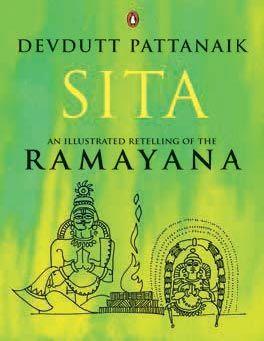
You feel your Ram has abandoned Sita, don’t you? She asked gently
He is God,---he abandons no one.
And I am the goddess, I cannot be abandoned by anyone
( Sita’s words to Lakshman before she leaves for the forest in adherence to Ram’s instructions).
Stories and anecdotes from the Ramayana have been like lullabies that my father told my sister and I every single night before we went to bed. A bed- time ritual that continued till I was twelve years old. Then came the television serial called “ Ramayana” in the year 1987 that took the entire country by storm. All the streets all over the nation were empty and deserted on Sunday mornings with not a soul in sight. Everyone was watching the tale of Ram and his beloved Sita (Or Sita and her beloved Ram). India had found its Sunday morning entertainment.
Through the stories that were told to me, the televised version of the epic and as I matured my own understanding, I grew to dislike Ram. The man who was the upholder of truth, the Mardayadpurshottam (The man who respects rules above all else) was not someone I idolized. He epitomised , for me, the rigidity of rules in a patriarchal society that were framed to ensure the supremacy of a man over a woman, the acute harm that excessive reliance on rules can bring to a person and his loved ones. For me the divine that is Ram was a symbol of what can go wrong in a society if laws and rules are treated as more important than the people for whom they are framed.
Devdutt Pattnaik’s Sita was an impulsive purchase a few weeks ago. It just came up when I was rying to look for a book to buy. The title intrigued me. The Ramayana has always been “Ram’s story” with his wife Sita being an integral part. Never has anyone referred to the Ramayana as Sita’s story. Being a person who is interested in understanding the aspects of gender in almost everything and how a gendered approach interprets things differently than the mainstream interpretation , I ordered the book hoping to read an alternative narration of the epic that would make me realize what Sita thought of the various events in her life.
I had not heard of the author till I chanced upon the book. The desk research that I did revealed that 44 year old Devdutt Pattnaik is a physician turned author and mythologist ( He has even done a course in Comparative Mythology from Mumbai University). His others works too are focused on Hindu Mythology.
I started reading the book with a lot of hope and a tad bit of apprehension. Hope of understanding the book from a feminist perspective which is sorely lacking in so far as the Hindu scriptures are concerned. My apprehension was reflected in questions like ‘‘What if it’s just the same old interpretation that I already know?” or “ Will the book contain answers to the innumerable questions I have had about Ram’ character, his motives of doing what he did?”, etc.
At many levels the book did not disappoint. I found it highly engaging, which for me is foremost as I already knew the story like the back of my hand. Story wise there was nothing new that the book could offer anyone with a prior knowledge of Hindu mythology. The novelty of the book, the “fresh approach” was that the author relies on different sources of Ramayana to weave the tale. The age old story brings in new anecdotes which one is oblivious to because exposure is limited to the mainstream version. The narration is effortless and highly interesting. It even manages to surprise you with the regional twists and turns that the author deftly incorporates into the main story line. This not only speaks volumes about the story-telling abilities of Pattnaik but his extensive research of various Ramayanas to write this book.
The book was a revelation to me. Till I read the book I was under the impression that all the regional works were mere translation of the “original” Ramayan. How wrong. For each era and century had its own interpretation which were rooted in the context of those times. Every re-telling viewed Sita and Ram is a slightly different light than the works written before and after it. The biggest revelation however was the way certain interpretations portrayed Sita.
The mainstream Sita has been always portrayed as someone who first obeyed her father and then her husband. A woman who embodies the values of a Pativrata Stri ( Woman who adheres to the code and conduct of marriage) and upholds chastity of mind and body above all else. Beyond the fact that Ram waged a war against Ravan to rescue his wife after she was abducted by him, nothing much is explored or told about Sita in the popular version. To me Sita was not just Ram’s wife or the princess of Janakpur, she was her own person and I wanted to know more about her. This book gave me a glimpse of what Sita might have been.
The book starts with Sita’s birth and talks about her childhood. I was very pleasantly surprised with this section. The coy, demure Sita , the forever obedient one and Ram’s shadow was nowhere to be found. Instead I saw an intelligent, well-educated and fearless woman who had very well developed intellect and a questioning bent of mind. Someone who is not just attracted to Ram (and Ram to her) but is drawn to him because he is able to answer her questions and clear her doubts, someone who can be her intellectual companion. The same goes for Ram. Sita’s confidence and fearlessness and not her coy disposition makes him fall in love with her. Thus for me, it deconstructs the popular belief that Ram “won” Sita as his wife. Yes he participated. Sita swyamvar but only because he loved her and wanted her as his wife. I would like to believe this version of an empowered Sita and the idea of falling in love before getting married. It appeals to my sensibilities of a woman being a free agent and a decision maker of her own life.
Just like Sita, the book explores the unexplored image of Ram. The popular image of Ram is that of a polite, obedient son and ruler who can go to any length to ensure that the reputation of his clan is safe and unblemished. He was a husband who is never known to express his love openly for his wife The alternate Ram that I was shown was a lovelorn man after his wife is nowhere to be found, a husband eager to give into slightly unreasonable demands of his pregnant wife out of love for her. A man who shows a rare display of impatience because a bird refuses to tell him where Ravan has taken his wife. A husband who is excited to meet his wife after knowing where she has been kept captive and a man who desires his lady love as only an impatient lover can and that of a heartbroken man when he realises that his Sita will never come back and commits suicide because he cannot imagine his life without her. I was able to see Ram from a more humane lens for the first time ever. The vulnerable man who sacrifices everything that he holds dear: his father, his wife and his brother. The last chapters made me weep for Ram and his loss. He was a lonely man amidst the crowd of people ; a defeated man who was left with nothing in the end. I felt his pain and for a moment I forgave him his biggest sin. The sin of not supporting the voice of reason and truth because the voice was of his wife and not his subjects.
Ramayan for me is a tragic love story where Sita and not Ram is the central character. After all, the major events are related to either Ram’s marriage to her or her abduction and rescue. So much so that the end of Sita signifies the end of Ram.
The dominant image of Ram portrayed in the book however is still that of a man who adheres to rules and enforces them at any cost. Ram values reputation of his person and clan more than supporting what is ‘just’ and fair for an individual. Ideas appeal to Ram more than the facts. He who will make sure that his wife proves her chastity by giving “agni- pareeksha” ( passing through the fire to prove purity of body and mind) because she stayed under another man’s roof and will not hesitate to banish her from the city and his life when people cast a shadow on her purity.
The book not only presents readers with different interpretations of the Ramayana but draws parallels with other religions as well of the anecdotes and the philosophy that Ramayana propagates, thus trying to establish that all major religions are based on similar core values and beliefs. Pattnaik also gives his own perspective in a few of the chapters by raising some fundamental questions about life and dharma.
I had picked up the book hoping something different and it wasn’t a let-down. Although the book fails to answer the eternal questions that I had about why Sita did not revolt when she was exiled or why Ravan did not claim Sita through force, I was hoping to find the in “Sita” . Why did Ravan not forcefully claim Sita when he could have done it so easily? Why did Ram defy all rules of war and kill Ravan in his navel ( where the nectar containing his life was stored) rather than his head ? Finally why did he allow himself to exile his wife to the forest based only on the rumour which he knew did not contain any shred of truth. As the upholder of the code of conduct was it not his responsibility to side with what is just even if it meant supporting his wife?
No matter how radical an interpretation is, it has its own limitations, especially when it comes to a religious epic. So is the case with this book, It tries valiantly to make the readers see the Ramayana in a different light but falls short of answering the basic question. This failure thus results in reinforcement of the popular image of the hero ( Ram) and the anti- hero ( Ravan) and reinforcement of my belief of “ Not wanting a Ram EVER in my life”.










Add new comment